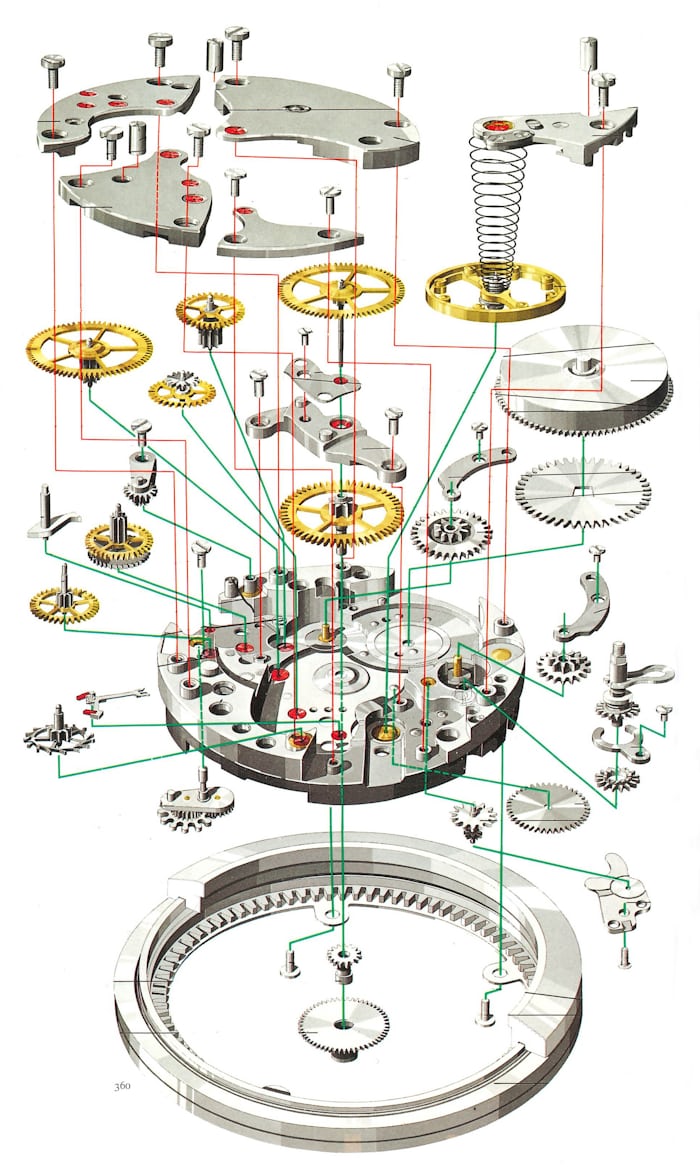Monday, May 30, 2011
Patek 3445 white gold with date

- Posted using BlogPress from my iPad
http://vintage-watch.blogspot.com/ https://www.facebook.com/groups/179047132263233/ https://www.instagram.com/maxbliss888_francis_phua/?hl=zh-cn





Wednesday, May 11, 2011












Patek Philippe ref. 3580A (Courtesy John Reardon / Collectability)

Back of Patek Philippe ref. 3580A (Courtesy John Reardon / Collectability)

Patek Philippe ref. 3563. (Credit: Sotheby's)
https://www.bobswatches.com/rolex-blog/watch-review/spotlight-patek-philippe-calatrava-3919.html
As an ordinary working man, I do not think I will have much opportunity to wear diamonds jewelry. As such, one of the way I can get to wear it subtlety is to get a watch with some small diamonds on its dial. Earlier on, I have tried the Elgin and the Rolex Datjust with diamonds and I am comfortable wearing them. The Rolex white no-lume diamond Rolex Day-Date 1803 seems like another good option. It has 8 diamond hour markers, baguette diamonds at 6 & 9 o’clock and day & date display at 12 & 3 o’clock with no luminous dotes or luminous on hands.
Some history. In 1956, the Oyster Perpetual Day-Date made its debut. Available only in 18 ct gold or platinum, it was the first wristwatch to display the date and day of the week spelt out in full in a window on the dial. With the President bracelet, originally created specially for it, the Day-Date continues to be the watch par excellence of influential people.
The white gold watch looks like stainless steel and it will be subtle enough to wear it for work. Several years ago, I was looking at one white gold 1803 but didn’t manage to get it. Finally i a, able to find one using two Datejust. The watch is probably one of the last batch from 1978.
Will look for a nice lizard skin leather strap for it. This is my second Day Date with the first one being Yellow Gold found in Bangkok when I was working there. I shall need to find a Rose gold Day Date..
網上資料 (kwsiu):歷史背景
1958年,繼 Ref. 6511 (c. 1956) 後,勞力士推出日誌型的第三代演進型號: 1803蠔式型錶款,裝載Cal. 1555機芯,具有星期及日期顯示(Day-Date),為當時的製錶界提供了一個新的思考方向,因為在當時即便其它高級品牌如百達翡麗、愛彼等,都尚未有這樣的錶款推出,也是同年代唯一可顯示全英文星期字顆的錶款,足見勞力士這款錶的重要性。
1803 維持了約 18 年的生產時間 (1960-1978),往後被 Ref. 180xx 型號於 1978 年所取代。 盡管如此,現今的日誌型亦繼承了始於1803 所獨有的高貴典雅,而又具非凡霸氣的 “總統” 形象,一直延續至今天。
紅旗它始建於1957年,與上海、天津並稱為中國三大手錶生產製造基地。50 年代的前進牌手錶、60 年代的遼寧牌手錶、70 年代的紅旗牌手錶至80 年代享譽全國的孔雀表,每一個品牌都是一段曆史,都是一段回憶,它為中國手錶工業的發展做出了突出貢獻。
“紅旗表”的面世離不開工匠們不服輸的精神。1970年,遼寧手錶廠的工程技術人員和工人組成了試製小組,並進行了新型手錶的設計和試製,這一舉動終獲成功,當年的投入批量生產產量高達15萬隻,使丹東手錶工業初具規模。1971年4月20日,輕工部通知:紅旗牌手錶(即“紅旗表”)技術鑒定合格。
到了1973年,遼寧手錶廠以“遼表革發(73)文件提出申請“紅旗牌”手錶(即“紅旗表”)啟用“H”商標(即HONGQI),使得每一隻“紅旗表”的後蓋都印有“紅旗(HONGQI)”的logo,隨後還增加了各種花色圖案,使之在外觀上更加增色。同年,遼寧手錶廠根據輕工部指令,轉產全國統一機芯手錶,當年年產40萬隻。
1970年,由遼寧手錶廠工程技術人員和工人自願組成“紅旗表”試製小組,進行新型手錶的設計和試製,當年投入批量生產產量達15萬隻,使丹東手錶工業初具規模。
1971年4月20日,輕工部通知:紅旗牌手錶(即“紅旗表”)技術鑒定合格。
1973年,遼寧手錶廠以“遼表革發(73)文件提出申請“紅旗牌”手錶(即“紅旗表”)啟用“H”商標(即HONGQI),每一隻“紅旗表”的後蓋都印有“紅旗(HONGQI)”的logo,隨後還增加了各種花色圖案,使之在外觀上更加增色。同年,根據輕工部指令,遼寧手錶廠轉產全國統一機芯手錶,當年年產40萬隻。
1978年2月8日,“紅旗表”大放異彩。新型“紅旗表”在丹東市內輕工產品商店展銷,十天內銷出704只,比展前十天銷量增加108.3%。1978年8月19日出版的《丹東日報》這樣評述:“‘紅旗牌’手錶猛追全國先進水平,手錶公司採取切實措施把產品質量放在第一位。”這次的展銷直接把“紅旗表”展現在全國人民面前,很多愛表人士慕名而來,只為目睹它的風采,即使是現在“紅旗表”也是眾多手錶收藏家們最愛的紅色手錶之一。
“紅旗表”象徵著中國手錶行業的發展,包含著光榮與希望,是一種強烈的民族責任,一種曆史使命感和一份愛國意誌,這抹“紅色之美”成為了一代人珍貴的回憶。
可惜的是在80年代特殊的背景下,遼寧手錶廠也受到影響,導致產品滯壓嚴重。經多方研討並在省、市主管部門支持下,遼寧手錶廠決定將預售的“紅旗表”全部收回,兌換新表,終獲成功,挽回信譽。公司將這一重大曆史轉折鄭重銘定為“難忘的一九七八年”以激勵永進。之後進入到90年代,遼寧手錶廠在外國產品陸續進入中國市場的衝擊下,也逐步陷入了經營低穀時期。
“紅旗表”曾是遼寧的驕傲,遼寧手錶廠雖沒落卻一直秉持初心,致力創造出具有民族特色的品牌。為了重振手錶產業,2008年7月,遼寧市政府同意由遼寧天賜投資(發展)集團有限公司收購重組了遼寧手錶廠,成立了遼寧孔雀表業有限公司,它先後完成了從遼寧手錶廠轉製、投資建設手錶工業園、恢復生產、技術革新、設備升級等一些列經營和生產方面的調整。並自主設計研發了薄型自動機械表機芯、運動碼表機芯、陀飛輪手錶機芯、多功能機芯、女表機芯等7大系列、326個花色品種,機械表機芯的設計、製造水平行業領先。2018年,還被中國鍾表協會評為中國陀飛輪手錶(丹東)製造基地。至此,遼寧手錶工業重歸行業巔峰。
“紅旗表”不僅僅是一種情懷的象徵,更是歲月的痕跡,它承載著人民生活的變化與希望,光榮與責任,時至今日也是收藏者們偏愛的具備紅色文化的手錶。
I have always long for a Longines Art Deco Tonneau watch as I used to have one in silver more than 20 years ago. Not sure why I sold it away...
